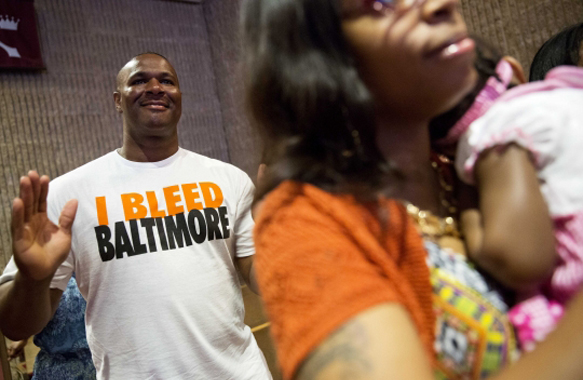By Juan M. Thompson | Originally Published at The Intercept. May 3, 2015 | Photographic Credit; David Goldman/AP
After prosecutor Marilyn Mosby charged six Baltimore police officers with the killing of Freddie Gray, this city, which had been roiled by protests since his death in police custody on April 19, appears to have calmed down.
Angry marches and demonstrations have been replaced by an almost festive and street fair-like atmosphere with marching bands, protesters on roller skates, and the selling of ice cream and T-shirts.
On Sunday, Mayor Stephanie Rawlings-Blake lifted the curfew that had been in effect for the past six days, further contributing to the impression of a return to normalcy. The prospect of things returning to normal, however, leaves many west Baltimore residents feeling deeply concerned.
“The last thing I want to come from this is to go back to the way things are,” said 22-year-old Brittany Byrd, who has been involved in the protests since Gray’s death.
“Yes. They were indicted. And yes it’s an important first step,” she said, “but these crumbs should be the beginning.”
Fellow protester Torrence Mosley echoed Byrd’s worries. “I feel a sense of complacency now,” he said. “I guarantee you the Baltimore six won’t be convicted.” The record supports Mosley’s anxiety. Though Mosby’s swift filing of charges against the six officers was a rare and bold move, it is even rarer for officers to be convicted for on-duty killings. Last month The Washington Post and Bowling Green State University teamed up for a report on police killings that found:
As hard as it is for prosecutors to win a conviction or an admission of guilt, it’s even harder to persuade a judge or jury to give an officer significant prison time. For the nine officers convicted in state prosecutions, sentences ranged from six months to seven years, The Post analysis shows. One of the other cases, the shooting death of the 92-year-old woman in Atlanta, was taken up by federal prosecutors, who added civil rights violations to manslaughter charges and won stiffer sentences, ultimately sending the two convicted officers to prison for six and 10 years.
“Even if they do get convicted (which they won’t be) they won’t spend much time in jail,” a local public defender, who asked to remain anonymous, told me. “People have to understand that in Baltimore the criminal justice system is tailor made to imprison and harass poor black people.”
As an example the public defender pointed to the case of Allen Bullock, who was photographed smashing the window of a police cruiser during Monday’s protests. Right now Bullock, 18, is in a Baltimore city jail facing eight misdemeanor charges.
Bullock’s bail is a stunning $500,000.
“The officers charged with Gray’s homicide received bail from $250,000-$500,000,” the public defender noted. “Is that not fucked up? Is that not a window into what’s wrong here?”
I spoke with Bullock’s mother Bobbi Small, who told me, “I don’t have that anywhere near that amount of money. This is how the system gets the people of Baltimore.”
I contacted the Baltimore City Attorney’s office for comment but received no response.
“They’ve grown adroit at pacifying people. I hope they don’t think this will pacify us,” West Baltimore resident Anthony Taylor said.
“The response here has never been just about Freddie Gray,” he explained. “The people are rising up against joblessness, police violence, and neglect.” Taylor also expressed concern about things returning to normal. “I fear that, yeah. Because if that happens this is for naught, know what I’m saying?”
Talking to Baltimore residents, it is clear they are worried about what the future holds. Will the police stop harassing them? Will there be jobs brought in to the community? Will their lives stay the same or be transformed?
Ferguson, New York, Chicago, Los Angeles, and now Baltimore have all been touched by passionate protests following police killing unarmed black people. But the protests have never just been about Mike Brown, Eric Garner, Rekia Boyd, Ezell Ford, or Freddie Gray. No, the protests in America’s biggest cities are a manifestation of the rage and frustration that many of the underprivileged—who are disproportionately black—feel about their lives in the world’s richest country.
Today the poorly kept basketball courts in West Baltimore are once again bustling with action. Children are riding their bikes. Children are playing in parks while their parents sit by smiling. And elderly women in big hats are trekking off to Sunday morning services. Meanwhile, the intersection of W. North and Pennsylvania Avenues, though still populated by some demonstrators, is no longer blocked off by police tanks and bulky, angry cops in riot gear.
But whatever happens with the six officers charged in Gray’s death, Sandtown-Winchester—the depressed west side neighborhood where Freddie Gray lived and the center of the protests—can never truly return to normal.
“I feel something,” said Taylor, a member of the Nation of Islam. “I feel as if there has been an awakening.”
He added, “We just can’t go back.”
Juan M. Thompson is a journalist with a focus on race and the criminal justice system. Prior to joining The Intercept, he worked as a production assistant and reporter at Chicago’s NPR member station WBEZ and as a reporter for DNAinfo Chicago. He lives in Brooklyn. | Follow Juan at Twitter @juanmthompson
This piece was reprinted by EmpathyEducates with permission or license. We thank the Author Juan M. Thompson for his kindness, observations, and giving voice to what we believe is a vital conversation.












Leave A Comment